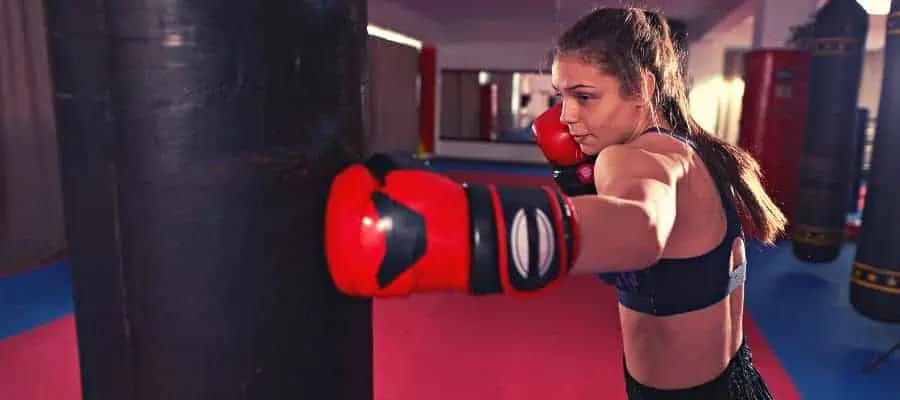Muay Thai is a very intricate martial art; learning it is hard on the body and straining on the mind. When learning about the history of this martial art, the culture it’s steeped in, and the techniques it practices, it’ll take one or multiple knowledgeable people to teach it properly.
But could learning Muay Thai online be a proper way? If you have a good and accessible gym, it’s better to learn muay thai there rather than from YouTube videos. For beginners, learning online would be a terrible idea. Video courses can lead to learning the technique improperly, and it will be difficult to correct in the future. Online videos can only help advanced students who have mastered fundamental muay thai skills.
Of course there are some things that can be learned from the video lessons for beginners too. These things can be a small introduction into the world of Muay Thai.
Things You Can Do With Online Training

The Basic Moves
Learning the basics from the internet can be a little dicey, given that there’s nobody there to hammer in on any small, minute things that one may be doing incorrectly. However, it’s not impossible! There are loads of very informative videos from well-accredited Muay Thai practitioners and fighters.
Learning little things such as what combinations to drill and how to move your feet; are things that can be learned from online videos.
Stretching
Being limber plays a massive part in Muay Thai! A lot of athleticism goes into play when throwing a quick head kick; being tight in the groin could be someone’s worst enemy when they see the opportunity to strike. Still, their body is too slow to take a moment by the reigns.
Conditioning
Have you ever taken a scooter to the shin? Hurts. Hurts really bad. Thankfully, shins can be conditioned, and they should be to deal with a painful martial art such as Muay Thai. Kicks will be defended with the shin, kicks sent will hit elbows, and almost any pain the body can feel will be felt.
Jogging, getting used to kicking complex objects, and anything that will help make the shins denser – these things will benefit someone training Muay Thai significantly. Further, these things can be done outside of a gym and with online videos!
Jogging and kicking a heavy bag will create micro-fractures in the shin; when the body fills these fractures, that makes the bone a bit denser.
Cardio
Yeah, the c-word. Some people like doing cardio. Others hate it with every fiber of their being. They want to do cardio is not up for debate when someone takes Muay Thai training seriously or any martial arts training.
Jogging, swimming, hill sprints – do the work outside the gym so that the work in the gym becomes easier. Or, in this case, the work at home because the home and the gym are synonymous when learning online.
Shadow Boxing
Shadow boxing is so essential to fighting! This act will play into the “flow” portion on a practitioner’s stat bar. It’s crucial to act defensively as well as offensively when shadow boxing. Footwork, hand speed, and technique will all be sharpened.
The best part is that one can shadowbox almost anywhere! There’s no difference, whether at the gym or in the kitchen.
Things That Are Better To Learn At A Gym

Fundamental Striking
It’s complicated to learn the basics correctly and correct bad techniques. Suppose someone is accustomed to throwing jabs incorrectly. In that case, it will be hard to rewire their muscle memory to adjust this jab and toss it out instinctively.
Jabs, teep kicks, roundhouse kicks – basic moves that are mandatory for Muay Thai will be learned much better and quicker at a gym with a savvy coach. Not only will one learn from someone who has done it, but they will make the correction to the novice’s techniques right there on the spot.
It is opposed to learning online, where immediate corrections aren’t available.
Questions
When learning Muay Thai, or anything for that matter, questions are bound to come up. Probably a lot of them, too. Muay Thai is very intricate – there are a lot of confusing parts and “what if?”s that come up. Whether it be a teammate, a coach, or anyone at the gym, there will be someone around who can help answer the question.
A quick question may have a quick answer or a three-book long answer. Still, at least it will be answered there, on the spot, as opposed to days later if the question is still living in one’s head and the fleeting thought that escapes as quickly as it came.
Sparring
Sparring is essential in combat sports. Learning how to punch means very little when one isn’t able to take a punch. As Mike Tyson said, “everyone has a plan until they get punched in the mouth.”
Yeah, that translates directly into Muay Thai, too. Learning how to be comfortable in bad situations isn’t just something to work on. Still, it’s a necessity for any great competitor. Things will not always go as planned, so it’s of the utmost importance to know what to do when plans A, B, and C have gone out the window.
However, sparring shouldn’t just be fighting. There are good ways to spar and terrible ways. Using up all of one’s toughness in the gym is an old way of training; competitors are in the gym to progress, not to win.
Further, controlled and light sparring adds longevity to a career, mitigates injuries (e.g., concussions, tears, breaks, etc.), and creates a healthier gym environment.
Motivation
We all need some words of encouragement every now and again, and it’s not bad to need outside motivators more than anyone else. Having like-minded people around creates a better training environment. It really fuels that competitive drive that is found in Muay Thai fighters.
Self-motivation is great, and everyone needs it. So be it the presence of others, the push from others, or any of the many beneficial factors from not training alone. In those cases, motivation will be abundant, especially compared to a solo-home gym where the only motivation is found in oneself.
Still, Muay Thai is demanding and can be very demoralizing sometimes. Having the extra training partners and faces at a gym can be the push that’’ put a competitor back on the saddle.
A Team
And to piggyback off of the motivation aspect of training at a gym, we’ll discuss how a team is another perk. Though a person training online can still have a team, it’s not the same as a team constructed of athletes who have bled and sweat together.
Tangible teammates can and will be there for each other more than an online coach and other online members can. So let’s say one is deciding between learning Muay Thai online and in person. Suppose they think they need to lean on outside factors beyond themselves to stick with it (spoiler alert: they will). In that case, the clear answer is to train in person at a legitimate gym.
How To Choose A Good Muay Thai School?

The initial gym a person chooses can make or break someone’s will to train Muay Thai or any martial art, for that matter. Many gyms offer free classes or trial weeks, so make the most of this! Attend a class at several gyms if there are multiple in the area.
Don’t just pay attention to the quality of Muay Thai, but be mindful of the facility and those that train there, and see if the vibe is right.
Further, look into what the gym offers! Who teaches there? What are their credentials? Who all trains there? Do they compete, or is this more of a hobbyist gym? Does this gym offer seminars with other Muay Thai fighters? These are all things to think about when picking a gym.
How Many Times A Week Should I Do Muay Thai?

Well, there are some factors to this. What do you want from Muay Thai? Are you looking to compete, or are you doing this as a hobby? Perhaps it’s for self-defense? Do you work? Also, how intense of a gym is it that you train at? If you’re training from home, what are you doing in terms of training?
Gym Training
For those that are training at a gym but aren’t planning on competing. You have the luxury of taking a week off without a forthcoming opponent trying to knock your head off, so there’s not much danger for gaps between sessions.
Those aspiring to compete in Muay Thai should aim for about five days a week. Rome wasn’t built in a day, same as Rodtang didn’t learn how to kick last year. So much time and effort go into being a great competitor in this sport, so the more training, the better.
However, time to heal and relax is significant, too. One won’t make it to train next week if they’re kicking their legs into oblivion this week. Take time to relax, heal, and care for the body.
Additionally, the love for training can be volatile; one day, you can train for hours and want to continue though the gym is closing. After wearing yourself thin, you can find yourself wanting to take breaks instead of closing the gym down.
Keep training fun as best as you can. Sure, it won’t always be fun if one wants to make a career out of it, but don’t train seven days a week for months until you hate it. Take some time to relax!
Home Training
If you’re training at home, then it depends on how hard you’re doing it. Are you learning from Tony Ferguson and kicking steel pipes? If so, take some time in between sessions. Are you shadowboxing and hitting the bag? Heck, train every day of the week! Remain injury-free, avoid burning out on the sport, and have fun!
If training isn’t taking a massive toll on the things you need to do daily (outside of being sore, that’s part of it), then train whenever you’re free! Obviously, the more, the better.
How Do You Train Your Legs For Muay Thai?

Conditioning shins is imperative for a Muay Thai fighter. Having one of your kicks checked is about as painful as stepping on a Lego while a Razor scooter spins into your chin and a skateboard pops up and hits you in the shin. Oh, and the pain of giving birth on top of that. Don’t question our science; there might be a bit of hyperbole, but it’s pretty close.
So yeah, how does one get tougher shins?
Jogging
Jogging is a great way to start! Jogging causes shin splints, and the body fills these microfractures, causing the bone to become denser and tougher.
Sparring
Sparring is another excellent way to condition shins! Actually, feeling kicks getting checked, checking other people’s kicks, and accidentally landing on the elbow will hurt in an actual fight. So why not train for that feeling first-hand? Nothing to replicate the real thing like the real thing!
Heavy Bag
Kicking a heavy bag is a surefire way to tough those shin bones! The lower the target, the better. Keep technique in mind, but for conditioning, a practitioner should think about repetition when kicking the bag. Also, diversify what you’re kicking with; the lower shin is typically where you want the point of impact, but there are exceptions and variables.
Hit the bag repeatedly and cover your skin’s surface area as much as possible! Also, don’t be afraid to land with your foot. The foot hitting isn’t ideal for roundhouse kicks, but it’s inevitable, especially when dealing with moving targets. Make sure your foot can handle this impact, too, but prioritize the shins!
If there aren’t any dying banana trees for you to kick down, then take a wooden stick and ding your shins with it. This doesn’t seem like much, but it helps weaponize those shin bones.
Recent Posts
What is Manachai's Fighting Style? Unveiling Muay Thai Mastery
Manachai, a celebrated figure in the Muay Thai world, has captivated audiences with his exemplary martial prowess. Hailing from the heartlands of Thailand, his name is synonymous with the art of...
What Was Chamuekpet Hapalang's Fighting Style? Unveiling Techniques
Chamuekpet Hapalang was a renowned figure in the world of Muay Thai (record 200-48-2), embodying a fusion of Muay Bouk and Muay Khao styles. Originating from Thailand, the art of Muay Thai is known...
